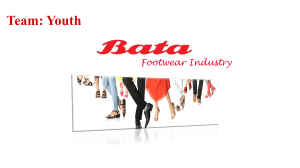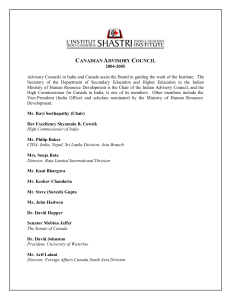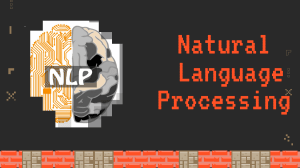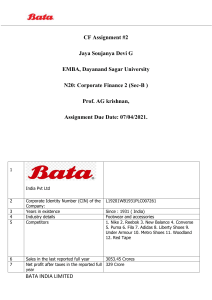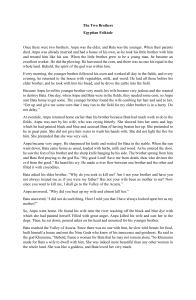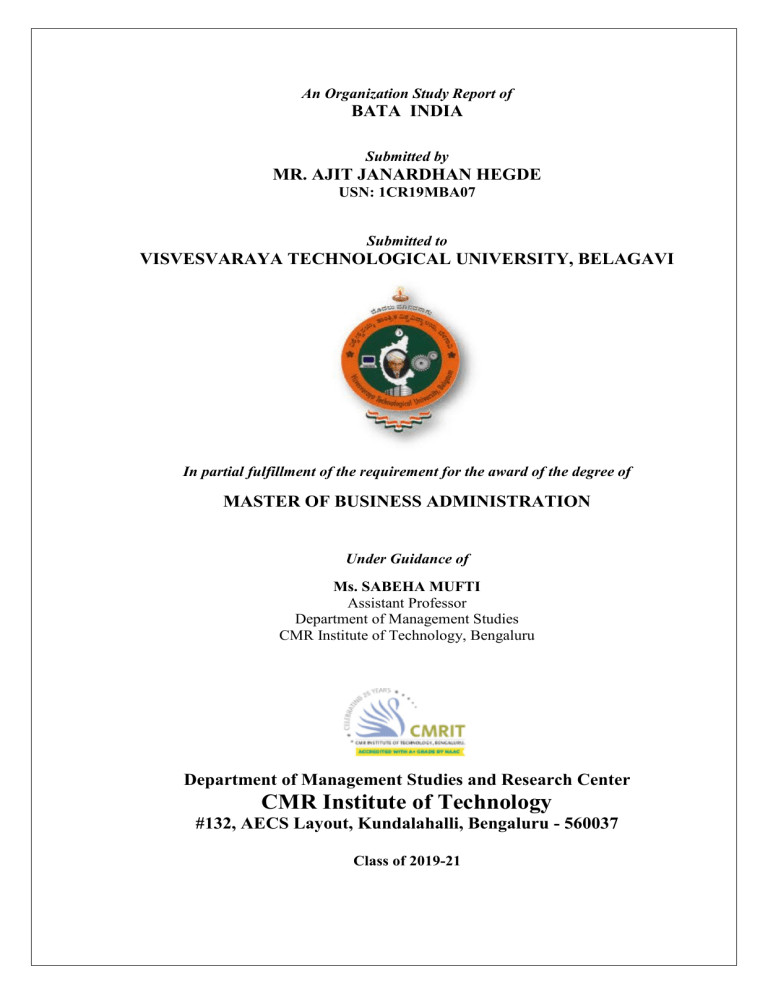
An Organization Study Report of BATA INDIA Submitted by MR. AJIT JANARDHAN HEGDE USN: 1CR19MBA07 Submitted to VISVESVARAYA TECHNOLOGICAL UNIVERSITY, BELAGAVI In partial fulfillment of the requirement for the award of the degree of MASTER OF BUSINESS ADMINISTRATION Under Guidance of Ms. SABEHA MUFTI Assistant Professor Department of Management Studies CMR Institute of Technology, Bengaluru Department of Management Studies and Research Center CMR Institute of Technology #132, AECS Layout, Kundalahalli, Bengaluru - 560037 Class of 2019-21 DECLARATION I, Mr. Ajit Janardhan Hegde bearing USN: 1CR19MBA07, hereby declare that the organization study report of BATA INDIA prepared by me under the guidance of Ms. SABEHA MUFTI faculty of M.B.A Department of CMR Institute of Technology, Bengaluru. I also declare that this report is prepared in partial fulfillment of the university Regulations for the award of degree of Master of Business Administration by Visvesvaraya Technological University, Belagavi. I have undergone an organization study for a period of four weeks. I further declare that this report is based on the original study undertaken by me and has not been submitted for the award of any degree/diploma from any other University /Institution. Place: Bengaluru Date: 28/09/2020 Signature of the Student USN: 1CR19MBA07 Disclaimer The enclosed document is the outcome of a student academic assignment, and does not represent the opinions/views of the University or the institution or the department or any other individuals referenced or acknowledged within the document. The data and Information studied and presented in this report have been accessed in good faith from secondary sources/web sources/public domain, including the organization‟s website, solely and exclusively for academic purposes, without any consent/permission, express or implied from the organization concerned. The author makes no representation of any kind regarding the accuracy, adequacy, validity, reliability, availability or completeness of any data/information here in contained. Place: Bengaluru Date: 28/09/2020 ( 1CR19MBA07 ) ACKNOWLEDGEMENT I acknowledge the deep gratitude to all those who have made organization study successful and helped in preparing the report. I would like to express my sincere thanks to Dr. Sanjay Jain, Principal of CMR Institute of Technology, Bengaluru for his valuable support and guidance throughout the course of organization study. I am grateful to Prof. Sandeep Kumar M, HOD of the Department of MBA, CMR Institute of Technology, Bengaluru for his constant motivation and inspiration. I thank my Internal Guide, Ms. SABEHA MUFTI, Professor of the Department of MBA, CMR Institute of Technology, Bengaluru for his constant guidance and support throughout the organization study. Mr. AJIT JANARDHAN HEGDE USN: 1CR19MBA07 TABLE OF CONTENTS Chapter Title No EXECUTIVE SUMMARY 1 INTRODUCTION Page No. 1 2-4 Introduction about Organization Industry Profile 2 ORGANIZATION PROFILE 5-15 Background Nature of Business Vision, Mission and Quality Policy Workflow Model Product/Service Profile Ownership Pattern Achievements/Awards Future Growth and Prospects 3 MCKENSY‟S 7S FRAMEWORK AND 16-20 PORTER'S FIVE FORCE MODEL McKensy‟s 7S Framework Porter's Five Force Model 4 SWOT ANALYSIS 21-22 5 ANALYSIS OF FINANCIAL 23-31 STATEMENTS 6 LEARNING EXPERIENCE 32 BIBLIOGRAPHY 33 LIST OF TABLES Table No. 01 02 03 04 05 Title Income Statement Balance sheet Analysis Cash flow analysis Per Share Data Ratio Analysis Page No. 23 25 26 28 30 LIST OF CHARTS Chart No. 01 02 03 04 05 Title Income Statement Chart Balance sheet Analysis Chart Cash Flow Chart Per Share data Chart Ratio Analysis Chart Page No. 24 25 27 29 30 BATA INDIA EXECUYIVE SUMMARY Bata India Limited is a manufacturer, wholesaler and retailer of footwear and related accessories. In retail, it operates a network of approximately 1,250 stores across India. The product line of the company comprises of footwear collection, which includes slippers, sandals, closed dress, closed casual, infants and sport shoes for men, women, children,school bags, socks, belts, polishes and brushes. In addition, the company offe rs various servicesincluding repairing and products warranty maintenance, gifts cards, and various discount offers. The company sells products of its in- house brand „Bata‟, and other international and national It operates five manufacturing units in India. The company is a subsidiary of Bata Shoe Organization and is headquartered in Gurgaon, Haryana, India. Bata India Ltd is the largest footwear retailer and the leader in the footwear industry in India. The company is engaged in the business of manufacturing and trading of footwear and accessories through their retail and wholesale network. They are having their production facilities at Batanagar in West Bengal, Patna and Hathidah in Bihar, Faridabad in Haryana, Bangalore in Karnataka and Hosur in Tamilnadu. Their wholly owned subsidiaries include Bata Properties Ltd and Coastal Commercial & Exim Ltd. The company operates in two segments, namely footwear & accessories, and investments in joint venture for surplus property development. Their Footwear & Accessories segment is engaged in the business of manufacturing and trading of footwear and accessories items through their retail and wholesale network. Their Investment in joint venture for surplus property development segment is involved in development of real estate at Batanagar. Their products include leather footwear, rubber/canvas footwear and plastic footwear. Bata India Ltd was incorporated in the year 1931 as Bata Shoe Company Pvt Ltd in Konngar, West Bengal, which was then shifted to Batanagar. Batanagar was the first manufacturing facility in the Indian shoe industry to receive the ISO 9001 certification. The company went public in 1973. They changed their name to Bata India Ltd. Over the years, the company has established a leadership position in the footwear industry and is easily the most trusted name in branded footwear. 1 CHAPTER - 01 INTRODUCTION INTRODUCTION ABOUT ORGANISATION Bata (also known as Bata Shoe Organisation) is a family-owned global footwear and fashion accessory manufacturer and retailer with acting headquarters located in Lausanne, Switzerland. Organised into three business units: Bata Europe, based in Italy; Bata Emerging Market (Asia, Pacific, Africa and Latin America), based in Singapore, and Bata Protective (worldwide B2B operations), based in the Netherlands, the organisation has a retail presence in over 70 countries and production facilities in 26 countries. Bata India is the largest retailer and leading manufacturer of footwear in India and is a part of the Bata Shoe Organization. Incorporated as Bata Shoe Company Private Limited in 1931, the company was set up initially as a small operation in Konnagar (near Calcutta) in 1932. In January 1934, the foundation stone for the first building of Bata‟s operation - now called the Bata. In the years that followed, the overall site was doubled in area. This township is popularly known as Batanagar. It was also the first manufacturing facility in the Indian shoe industry to receive the ISO: 9001 certification. The Company went public in 1973 when it changed its name to Bata India Limited. Today, Bata India has established itself as India‟s largest footwear retailer. Its retail network of over 1200 stores gives it a reach / coverage that no other footwear company can match. The stores are present in good locations and can be found in all the metros, mini-metros and towns Bata‟s smart looking new stores supported by a range of better quality products are aimed at offering a superior shopping experience to its customers. The Company also operates a large non retail distribution network through its urban wholesale division and caters to millions of customers through over 30,000 dealers. 2 COMPANY PROFILE Asia„s largest footwear company strives to maintain its lead with an image of superiority, professionalisms and round the clock efficiency. A visit to any factory or office in the country bears testimony to that. Bracing to meet the 21st century, Bata is gearing itself with the latest in technology and a forward-looking approach to human resource development. Staggering 16,000 people work at various functional centers in Bata India. While another 2,00000 are indirectly employed. The world of Bata India: There are four factories, at Batanagar near Calcutta now it is Kolkata, at Faridabad in Haryana, Bataganj near Patna in Bihar and at Peenya in Bangalore. Taking stock of them all means accounting for thousand of trained men and women, millions of pairs of footwear on the production line. The people –our assets: The Company firmly believes that giving its people the right encouragement, yields incomparable rewards. Even with technology and progress man doesn„t take second place at Bata India. Emphasis is given to man management and every opportunity is given so that people can grow with the organization. Each year a large number of regional, national and international courses are held to train Bata employees. it is a Bata policy to provide equal opportunity, to promote on merit and to stimulate it„s people into thinking globally .always abreast with current trends and technology, Bata India brings latest in line technology in factory, and the workers to many all to mated industries where 3 work force shrink in direct proportion to their rate of technological thinking .Bata India keeps its employment levels steady. Bata India is the largest retailer and leading manufacturer of footwear in India and is a part of the Bata Shoe Organization. Incorporated as Bata Shoe Company Private Limited in 1931, the company was set up initially as a small operation in Konnagar (near Calcutta) in 1932. In January 1934, the foundation stone for the first building of Bata„s operation - now called the Bata. In the years that followed, the overall site was doubled in area. This township is popularly known as Batanagar. It was also the first manufacturing facility in the Indian shoe industry to receive the ISO: 9001 certification. The Company went public in 1973 when it changed its name to Bata India Limited. Today, Bata India has established itself as India„s largest footwear retailer. Its retail network of over 1200 stores gives it a reach / coverage that no other footwear company can match. The stores are present in good locations and can be found in all the metros, minimetros and towns Bata„s smart looking new stores supported by a range of better quality products are aimed at offering a superior shopping experience to its customers. The Company also operates a large non retail distribution network through its urban wholesale divisionand caters to millions of customers through over 30,000 dealers. Bata has the following brands operating under its umbrella: Bata, Mocassino, North Star, Marie Claire, Bubblegummers, Ambassador, Hush Puppies, Scholl, Comfit, Power, Sparx, Reebok, Weinbrenner, Naturalizer, Bata and I. But the promotional campaign has to be designed only for the original and classic brand ―Bata‖, which is about finding STYLE – that agrees with the consumers„ tastes, meet their diverse needs, meet their budget, and fulfill their well-being. Product Attributes Comfortable and Trendy Footwear Easy to Maintain Contemporary Styles with International Know-How High Quality at affordable prices Versatile products to suit each occasion 4 CHAPTER – 02 ORGANIZATION PROFILE BACKGROUND Our history and language are full of reference to shoes and chappals and the time honored craft of show and chappal making. Shoemakers were the first craftmen to establish guilds in the middle ages and through the builds societies of craftsmen within a common trade come a standard of quality, which earned the shoemaker a well-established position in the community. The quality and care the shoemaker has taken with his craft has earned him a place in the history and Bata shoe organisation is proved to follow in this tradition of time quality craftsmanship. Today Bata shoe organisation is truly “Shoemaker and chappal maker to the world” and we invite you to join us and learn a little about the long history of shoes and how they are designed and constructed. Primitive man made his own shoes from the skins of the wild animal he hunted and, where the climate was cold, he tied or around his lower leg. Primitive men were for the most part, nomadic and he bound his feet for protection against the bites of insect, often thorny forest flow and the heat of the earth on the dry plains. How the primitive men bound his feet dependent on where lived and this form the very beginning we see that shoes were used for protection but that to some extent the environment, the weather and the land dictated style. Thus, sandal was the earliest from of show made by a “specialist” shoemaker. The early Egyptians made sandals, which consisted of a sole head to the foot by single piece of leather, which is circled the big toe. This from of sandal is called a thongs are still popular today in certain parts of the world. The Egyptian had an interesting custom, which indeed seems to be or origin of expression under foot. The Egyptian painted or carved images of their enemies on the bottom of their sandals. They believed, they could hurt their foe by treading on their image, hence the expression; to be under foot” Early shoe design was often taken from nature and in addition to sandals the Egyptians also wore a shoe within up turned toe model on the elephants tusk. The Mesopotamian used the same design, but with a longer curved toe. Some believed that the Chinese might 5 have originated the curved toe design, as the boat with a peaked toe is quite common among the Mongols today. The early Greeks where barefoot except in foul weather and it was not until the Hellenistic period around 232 BC that going barefoot out of dears become a sign of slavery. At that time the wearing of shoes signified that the wearer was free and beginning barefoot come to signify that the person was a slaved. Early Greek shoes were made from one piece of leather, which was drawn over the foot by a threaded throng and tied around the ankle. The Romans carried their shoe style throughout the ancient world as the conquered. They brought “Roman Style” shoes to French and to Britain. The Moons who conquered the Spain in the 8 th century (711 AD), introduced a beautifully – soft-dyed leather known as Cordovan. Their shoes fit snugly and covered the foot and the ankle. They came to be called “Babylonian” shoes. Thus we see the different materials different regions of the known world. As people traveled, traded, conquered, shoes style was carried from one region to another. The shoemaker became a specialist, a respected, influential and need member of the society. Shoes and chappals where made for specific uses, designed for specific climates and where often decorated to harmonies with clothing style. Leather, wood and plant elements (rice stalk in China and palm leaves in Egypt) where the primary materials utilized in shoe making. This history of shoes very much apart of all history. In the beginning necessity dictated style and then though conquest, travel and trade, styles where exchanged among the people of the world materials varied and decoration in footwear became popular to and luxurious.. Simplicity then returned and shoes reflected the egalitarian ideas of the day. Craftsmen shoemakers in single pairs produced one shoe; each cut, stitched and tracked by hand in a time consuming, laborious method. The result; an expensive, custom- made pair of shoes design in accordance with specifications and whims of a wealthy client, more often than not a privileged member of a select segment of society. The industrial revolution of the 19 th changes century was to bring about vast in the shoemakers‟ craft, transforming the art though mass production techniques into a rapid, highly automated, mechanical process. For the first time 6 in history, good quality people, thus achieving the long- short-after dream. In turn, the automation of the shoe industry gave reach to the modern fashion – oriented footwear industry. As peoples basic demanded and sought after more specialized footwear; footwear for sports, for leisure, for work, footwear that satisfied needs of both fashion and function. Today the footwear industry, the assimilation of scientific methods and the findings of modern radical research particularly in the realm of sports medicine in developing footwear in accordance with the physiology of the human foot and the dynamics of the body in motion. Placed on reality. Ever looking to the future with optimism. This is the golden profile of Bata India. NATURE OF BUSINESS Bata India is the largest retailer and leading manufacturer of footwear in India and is a part of the Bata Shoe Organization. Incorporated as Bata Shoe Company Private Limited in 1931, the company was set up initially as a small operation in Konnagar (near Calcutta) in 1932. Industry : Retail Manufacturing VISION “Vision is that igniting spark that can inspire and energies people to do better. The focus of vision is to reach out hungrily for the future and drag it into the present. Bata India today wishes to reposition itself as a market driven, fashion conscious lifestyle. Focus on a variety of customer groups.” MISSION “A mission statement articulates the philosophy of the company with respect to the business in specific and society in general. Once the mission statement of company is finalized and adapted, it provides a readymade guideline to employees of the organization about its principles, policies and practices. Bata will provide its products and services to all the age groups in the community. Will also provide the finest quality through customer involvement.” 7 QUALITY POLICY BATA‟s quality policy is based on the Bosnia and Herzegovina's state policy in the field of accreditation and is defined by the BIH Law on Accreditation and the BiH Law Establishing the Institute for Accreditation whereby BATA has been authorized to implement that policy. “BATA products are manufactured with the utmost care and stringent quality control is always maintained. However, despite this high quality assurance, there can be few odd defective ones among the millions we manufacture and sell.” Impartiality policy is one of the BATA's key policies which guarantees equal access to all conformity assessment bodies, ensures objectivity of accreditation activities and regulates the importance of the management of conflict of interest. Exchange of experience and cooperation with other accreditation bodies is another opportunity for strengthening the status of accreditation in Bosnia and Herzegovina. Therefore, BATA is open for any new project that would support the development of accreditation. Aware of the importance of accreditation in the quality infrastructure, BATA continuously works on providing opportunities for education and new practical experiences for permanent and external staff. In the implementation of its quality policy, BATA works towards meeting general quality objectives including the following: Maintain the status of EA MLA bilateral signatory in the relevant fields and promote the importance of this agreement, Monitor the needs of interested parties and timely react and establish new accreditation schemes and sign EA MLA in the fields relevant to Bosnia and Herzegovina, Actively participate in the work of international accreditation organizations, Cooperate with accreditation bodies from the neighboring and other countries, Raise awareness about accreditation as the most adequate and internationally recognized tool for confirmation of CAB's competence, Cooperate with the state-level and entity-level authorities in the field of accreditation, Cooperate with other quality infrastructure institutions, 8 Have access to an adequate pool of assessors and/or experts to be able to perform a high-quality accreditation process, Eliminate or minimize any risks that could potentially compromise the Accreditation System of Bosnia and Herzegovina. WORKFLOW MODEL A workflow model is the sequential series of tasks and decisions that make up a business process. Designing a workflow model lets business users see how a process works and helps them streamline and optimize it for best results and high efficiency. A workflow model is easy to define and understand. The specific set of rules and paths that anyone would follow in an organization to complete their respective tasks are referred to as processes, tasks, or workflows. The rules and policies that act as guidelines are the ones that are implemented with the help of workflows. The concept is quite similar to setting up roadways for miles because there will be plenty of hurdles, obstacles created by others, and changes that need to be implemented. As long as workflow models are evolutionary with the ability to adapt to changes, they will continue to be conducive to a productive environment. Sometimes, users will be inclined to keep things simple and get it over with. 9 PRODUCT / SERVICE PROFILE Wide product assortment : Bata Collections target a wide range of customers and offer an excellent pricequality ratio. Bata‟s exclusive models along with national and international brands are carefully selected and updated in response to market demand. Personalized service : Qualified and enthusiastic sales associates who take customer‟s satisfaction to heart. In many countries customer service goes beyond the stores with home deliveries, orders made possible via catalogues, the web or even call centers Clear product merchandising : Easy-to-shop store layout with clear product display by category and by style. 10 OWNERSHIP PATTERN Historical FII holding in Bata India Ltd. Promoters holding marginally changed to 52.96% as of Jun 2020 qtr. FII/FPI have decreased their holdings by 2.33% of holdings in Jun 2020 qtr Mutual Funds holding marginally changed to 15.93% as of Jun 2020 qtr. ACHIEVEMENTS / AWARDS Bata India awarded the prestigious Images award 2009 Bata India, the leading footwear retailer in the country was awarded the Images award for the Most Admired Retailer of the Year – Fashion & Lifestyle. This was announced at the India Retail Forum in Mumbai, where the top retail companies in India con Expending & nurturing the largest footwear retail network A retail network of over 1200 stores gives us a reach unmatched by any other company. The Bata Shoe Store is amongst the most recognisable and favoured landmark in any major market in India. Bata India continues with its Super brand status The Bata brand was chosen after a very in-depth and detailed evaluation procedure. Marketing and Business professionals who compromise the Super brands Council evaluate and select on parameters like trust, emotional loyalty and re-call of the brand which creates strong customer loyalty 11 Bata India awarded Amity Corporate Excellence Award Bata India Ltd. has been awarded the Amity Corporate Excellence Award for Best Retail Chain. This is the third time in a row that Bata India has been honoured with this prestigious award for Corporate Excellence. The Corporate Excellence Awards are held annually by Amity International Business. Amity Corporate Excellence Bata India has been awarded the AMITY CORPORATE EXCELLENCE AWARD on 21st February 2008. This award has been given for Bata's excellent performance and retail growth during the past year. IMAGE Retail Award This award was received in the footwear category on on 6th September 2007. This award was a part of Reid & Taylor Awards for Retail Excellence presented during India Retail Summit 2006. Super Brands Award It is awarded to the 1st top ten Super brands of India. Super brand signifies the recognition that the consumer is giving to the Brand Image, Brand Value and Brand Delivery. The award ceremony was held in Mumbai on 12th April 2007 FMCG Consumer Reaction Award Bata won FMCG Consumer Reaction Award in Fashion & Specialties (Shoes) on March 2007. The Award was presented by: Bharati Vidyapeeth's Institute of Management Studies & Research 12 Lycra Images Fashion Awards Bata is honoured for 3 consecutive years as Most Admired Brand of the year in Footwear Category on 25th January 2007. Retailer of the Year Award This award was received on 24th Nov 2006 in the footwear category. This award was a part of Reid & Taylor Awards for Retail Excellence presented during India Retail Summit 2006. Amity Corporate Excellence Award This award was given to Bata by Amity International Business School on 22nd – 24th Feb 2006 for having achieved an enviable position of one of the best and most admired company of the world with their unparalleled performance. Super Brands Awards It is awarded to the 1st top ten Super brands of India on 23rd Sept 2005. Super brand signifies the recognition that the consumer is giving to the Brand Image, Brand Value and Brand Delivery Retail Asia Pacific Top 500 Awards Bata won the Top Retailer 2006-India Bronze award on 7th Sept 2005. This award is given by Retail Asia Pacific TOP 500 13 FUTURE GROWTH AND PROSPECTS The organization is the world‟s largest manufacturer and marketer of footwear. It has 83 companies spread all over the globe both in developed and developing countries. The organization is the leader in the use of modern technology and the latest management and marketing techniques. Its 73 manufacturing units produce a vastly comprehensive line of footwear from women‟s high fashion shoes to artic boots; men‟s dress shoes to popular sports shoes for the children. It operates 6300 company owned stores all over the world. This includes Bata family Athletes world Bubble gummers, Rizzi, Heyraud and Marie Claire stores. In addition Bata has around 50 thousands retailers the combined production and sales total 270,000,000 pairs of shoes per year. The Bata shoe organization has 67 thousands employees on its roles today. Bata limited; the world headquarters of Bata shoe organization located in Toronto is manned by experts in manufacturing, marketing, finance, product development and personnel. A work force that is available for training and guidance in all operations in the field. Today Bata India has become a legend behind it‟s a sage of determination and pursuit of excellence. A spirit of enterprise that has made Bata India a complex, multidimensional giant ever at the service of millions of people in India. How did it all begin? Today the largest footwear manufacturer is India. The biggest footwear market has wide wingspan-it covers the entire length and breath of the country. The company prides itself in having your manufacturing units, two tanneries, and a number of ancillary units. Pursuing an active policy of encouraging exports since 1935, Bata India exports the largest number of canvas shoes from the country. In March 2018, Bata India Limited (NSE:BATA INDIA) released its earnings update. Generally, analyst consensus outlook appear cautiously optimistic, with profits predicted to increase by 29% next year relative to the past 5-year average growth rate of 1.6%. Currently with trailing-twelve-month earnings of ₹2.2b, we can expect this to reach ₹2.8b by 2019. Below is a brief commentary on the longer term outlook the market has for Bata India. For those keen to understand more about other aspects of the company 14 What can we expect from Bata India in the longer term? The view from 10 analysts over the next three years is one of positive sentiment. Broker analysts tend to forecast up to three years ahead due to a lack of clarity around the business trajectory beyond this. To understand the overall trajectory of BATAINDIA‟s earnings growth over these next few years, I‟ve fitted a line through these analyst earnings forecast to determine an annual growth rate from the slope. From the current net income level of ₹2.2b and the final forecast of ₹4.0b by 2021, the annual rate of growth for BATAINDIA‟s earnings is 19%. This leads to an EPS of ₹31.27 in the final year of projections relative to the current EPS of ₹17.16. In 2021, BATAINDIA‟s profit margin will have expanded from 8.4% to 11%. 15 CHAPTER – 03 MCKENSY’S 7S FRAMEWORK AND PORTERS’S FIVE FORCE MODEL MCKENSY‟S 7S FRAMEWORK The McKinsey 7S Framework is a management model developed by business consultants Robert H. Waterman, Jr. and Tom Peters (who also developed the MBWA-- "Management By Walking Around" motif, and authored In Search of Excellence) in the 1980s. This was a strategic vision for groups, to include businesses, business units, and teams. The 7 Ss are structure, strategy, systems, skills, style, staff and shared values. The model is most often used as an organizational analysis tool to assess and monitor changes in the internal situation of an organization. The model is based on the theory that, for an organization to perform well, these seven elements need to be aligned and mutually reinforcing. So, the model can be used to help identify what needs to be realigned to improve performance, or to maintain alignment (and performance) during other types of change. Whatever the type of change – restructuring, new processes, organizational merger, new systems, change of leadership, and so on – the model can be used to understand 16 how the organizational elements are interrelated, and so ensure that the wider impact of changes made in one area is taken into consideration. Strategy: this is organization's plan for building and maintaining a competitive advantage over its competitors. Structure: this how company is organized (that is, how departments and teams are structured, including who reports to whom). Systems: the daily activities and procedures that staff use to get the job done. Shared values: these are the core values of the organization, as shown in its corporate culture and general work ethic. They were called "superordinate goals" when the model was first developed. Style: the style of leadership adopted. Staff: the employees and their general capabilities. Skills: the actual skills and competencies of the organization's employees. 17 Usage Improve the performance of a company Examine the likely effects of future changes within a company Align departments and processes during a merger or acquisition Determine how best to implement a proposed strategy The framework gives rise to a few vital points, like: What type of analysis is this? Or what is the action triggered after putting your organization into this drill? Does this give you real guidelines as to how to proceed further, after the analysis is completed? Do we treat this as a guideline or checklist and proceed with using other techniques to formulate further steps? There have been other techniques in vogue which have to be used to arrive at actionable points. Here too, a similar approach may be needed, as a tool, to really put this into action. The above seems to be an abstract list of generic elements in any organization. It does not spell out which steps are to be initiated to improve each business process, such as Marketing, Finance, Manufacturing etc. PORTERS‟S FIVE FORCE MODEL Porter's Five Forces is a model that identifies and analyzes five competitive forces that shape every industry and helps determine an industry's weaknesses and strengths. Five Forces analysis is frequently used to identify an industry's structure to determine corporate strategy. Porter's model can be applied to any segment of the economy to understand the level of competition within the industry and enhance a company's long-term profitability. The Five Forces model is named after Harvard Business School professor, Michael E. Porter. 18 Porter's Five Forces is a business analysis model that helps to explain why various industries are able to sustain different levels of profitability. The model was published in Michael E. Porter's book, "Competitive Strategy: Techniques for Analyzing Industries and Competitors" in 1980.1 The Five Forces model is widely used to analyze the industry structure of a company as well as its corporate strategy. Porter identified five undeniable forces that play a part in shaping every market and industry in the world, with some caveats. The five forces are frequently used to measure competition intensity, attractiveness, and profitability of an industry or market. Porter's five forces are: Competition in the industry Potential of new entrants into the industry Power of suppliers Power of customers Threat of substitute products KEY TAKEAWAYS Porter's Five Forces is a framework for analyzing a company's competitive environment. The number and power of a company's competitive rivals, potential new market entrants, suppliers, customers, and substitute products influence a company's profitability. Five Forces analysis can be used to guide business strategy to increase competitive advantage. The Five Forces model can help businesses boost profits, but they must continuously monitor any changes in the five forces and adjust their business strategy. Porter's Five Forces is a business analysis model that helps to explain why various industries are able to sustain different levels of profitability. The model was published in Michael E The five forces are frequently used to measure competition intensity, attractiveness, and profitability of an industry or market. 19 In order to devise a competitive strategy for BATA, we need to analyze Porter„s Five Forces Model. The model analyses the different aspects of attractiveness and competitiveness of the market. 20 CHAPTER – 04 SWOT ANALYSIS SWOT analysis of Bata analyses the brand/company with its strengths, weaknesses, opportunities & threats. In Bata SWOT Analysis, the strengths and weaknesses are the internal factors whereas opportunities and threats are the external factors. SWOT Analysis is a proven management framework which enables a brand like Bata to benchmark its business & performance as compared to the competitors and industry. As of 2020, Bata is one of the leading brands in the lifestyle and retail sector. The table below lists the SWOT (Strengths, Weaknesses, Opportunities, Threats), top Bata competitors and includes Bata target market, segmentation, positioning & Unique Selling Proposition (USP). BATA STRENGTH Bata has a worldwide Presence in over 70 countries and production facilities in 27 countries Benefit received from link to the international organization for back-office systems, product innovations and sourcing. Bata showrooms are found in all the major cities, mini-metros and towns Sells through over 1200 retail stores in India and 5000 stores worldwide Bata company employs more than 6800 people in India and 40000 people world over and over 30,000 dealers Excellent advertising and brand presence Wide range of footwear including ladies sandals, heels, sports shoes, men formal shoes, trek shoes, accessories etc BATA WEAKNESS High cost for brand protection for Bata products Intense competition in the footwear segment means limited scope to overhaul market share 21 BATA OPPORTUNITIES People now look towards buying footwear as a blend of fashion and comfort, so now has an increasing market size Bata has an opportunity to create a separate division for tackling the rural markets in emerging nations Global expansion in the premium footwear section BATA THREATS Intense competition from other leading footwear brands can affect Bata's margins Commoditization if fashion footwear not differentiated well COMPETITORS Nike Reebok New Balance Converse Puma Fila Adidas Liberty Shoes 22 CHAPTER – 05 ANALYSIS OF FINANCIAL STATEMENT BATA INDIA INCOME STATEMENT ANALYSIS Operating income during the year rose 11.3% on a year-on-year (YoY) basis. The company's operating profit increased by 35.8% YoY during the fiscal. Operating profit margins witnessed a fall and down at 16.3% in FY19 as against 13.3% in FY18. Depreciation charges increased by 6.0% and finance costs decreased by 15.5% YoY, respectively. Other income grew by 35.5% YoY. Net profit for the year grew by 49.2% YoY. Net profit margins during the year grew from 8.2% in FY18 to 11.0% in FY19. Table - 01 BATA INDIA Income Statement 2018-19 No. of Mths Year Ending 12 Mar-18* 12 Mar-19* % Change Net Sales Rs m 26,342 29,311 11.3% Other income Rs m 503 682 35.5% Total Revenues Rs m 26,845 29,993 11.7% Gross profit Rs m 3,514 4,771 35.8% Depreciation Rs m 605 641 6.0% Interest Rs m 42 36 -15.5% Profit before tax Rs m 3,370 4,777 41.7% Tax Rs m 1,165 1,487 27.6% Profit after tax Rs m 2,205 3,290 49.2% Gross profit margin % 13.3 16.3 Effective tax rate % 34.6 31.1 Net profit margin % 8.2 11.0 23 Chart 01 30000 25000 20000 15000 10000 5000 12 Mar-18* 12 Mar-19* % Change 0 -5000 BATA INDIA BALANCE SHEET ANALYSIS The company's current liabilities during FY19 stood at Rs 6 billion as compared to Rs 6 billion in FY18, thereby witnessing an increase of 12.3%. Current assets rose 18% and stood at Rs 18 billion, while fixed assets rose 7% and stood at Rs 3 billion in FY19. Overall, the total assets and liabilities for FY19 stood at Rs 25 billion as against Rs 21 billion during FY18, thereby witnessing a growth of 16%. 24 Table 02 BATA INDIA Balance Sheet as on March 2019 No. of Mths Year Ending 12 Mar-18* 12 Mar-19* % Change Networth Rs m 14,747 17,418 18.1 Current Liabilities Rs m 5,608 6,297 12.3 Long-term Debt Rs m 0 0 0.0 Total Liabilities Rs m 21,414 24,741 15.5 Current assets Rs m 15,549 18,405 18.4 Fixed Assets Rs m 3,070 3,300 7.5 Total Assets Rs m 21,414 24,741 15.5 Chart 02 25000 20000 15000 10000 5000 0 12 Mar-19* 12 Mar-18* 12 Mar-19* 25 BATA INDIA CASH FLOW STATEMENT ANALYSIS BATA INDIA's cash flow from operating activities (CFO) during FY19 stood at Rs 3 billion, an improvement of 115.3% on a YoY basis. Cash flow from investing activities (CFI) during FY19 stood at Rs -3 billion, an improvement of 148.1% on a YoY basis. Cash flow from financial activities (CFF) during FY19 stood at Rs -631 million on a YoY basis. Overall, net cash flows for the company during FY19 stood at Rs 43 million from the Rs -72 million net cash flows seen during FY18. Table 03 BATA INDIA Cash Flow Statement 2018-19 No. of months 12 Year Ending Mar18 Mar19 Cash Flow from Operating Activities Rs m 1,603 3,451 115.3% Cash Flow from Investing Activities Rs m -1,119 -2,777 - Cash Flow from Financing Activities Rs m -556 -631 - Net Cash Flow Rs m -72 43 - 12 Particulars % Change 26 Chart 03 18-Mar Cash Flow from Operating Activities Cash Flow from Investing Activities Cash Flow from Financing Activities Net Cash Flow 19-Mar Cash Flow from Operating Activities Cash Flow from Investing Activities Cash Flow from Financing Activities Net Cash Flow CURRENT VALUATION FOR BATA INDIA The trailing twelve-month earnings per share (EPS) of the company stands at Rs 25.6, an improvement from the EPS of Rs 17.2 recorded last year. The price to earnings (P/E) ratio, at the current price of Rs 1,345.0, stands at 52.4 times its trailing twelve months earnings. 27 The price to book value (P/BV) ratio at current price levels stands at 8.0 times, while the price to sales ratio stands at 4.7 times. The company's price to cash flow (P/CF) ratio stood at 44.0 times its endof-year operating cash flow earnings. Table 04 Per Share Data/Valuations No. of Mths Year Ending 12 Mar-18* 12 Mar-19* Sales per share (Unadj.) Rs 204.9 228.0 TTM Earnings per share Rs 17.2 25.6 Diluted earnings per share Rs 17.2 25.6 Price to Cash Flow x 61.5 44.0 TTM P/E ratio x 52.4 52.4 Price / Book Value ratio x 5.9 8.0 Rs m 172,873 172,869 Rs 4.0 6.3 Market Cap Dividends per share (Unadj.) 28 Chart 04 250 200 150 100 50 12 Mar-18* 0 12 Mar-19* RATIO ANALYSIS FOR BATA INDIA Solvency Ratios Current Ratio: The company's current ratio improved and stood at 2.9x during FY19, from 2.8x during FY18. The current ratio measures the company's ability to pay shortterm and long-term obligations. Interest Coverage Ratio: The company's interest coverage ratio improved and stood at 135.6x during FY19, from 81.2x during FY18. The interest coverage ratio of a company states how easily a company can pay its interest expense on outstanding debt. A higher ratio is preferable. Profitability Ratios Return on Equity (ROE): The ROE for the company improved and stood at 18.9% during FY19, from 15.0% during FY19. The ROE measures the ability of a firm to generate profits from its shareholders capital in the company. Return on Capital Employed (ROCE): The ROCE for the company improved and stood at 27.6% during FY19, from 23.1% during FY18. The ROCE measures the 29 ability of a firm to generate profits from its total capital (shareholder capital plus debt capital) employed in the company. Return on Assets (ROA): The ROA of the company improved and stood at 13.4% during FY19, from 10.5% during FY18. The ROA measures how efficiently the company uses its assets to generate earnings Table 05 Key Ratio Analysis No. of Mths Year Ending 12 Mar-18* 12 Mar-19* x 2.8 2.9 Days 12 8 Interest coverage x 81.2 135.6 Debt to equity ratio x 0.0 0.0 Return on assets % 10.5 13.4 Current ratio Debtors‟ Days Chart 05 250 200 150 12 Mar-19* 100 12 Mar-18* 50 0 Current ratio Debtors’ Days Interest coverage Debt to equity ratio Return on assets 30 BATA INDIA SHARE PRICE PERFORMANCE Over the last one year, BATA INDIA share price has moved up from Rs 825.9 to Rs 1,345.0, registering a gain of Rs 519.1 or around 62.9%. Meanwhile, the S&P BSE FMCG Index is trading at Rs 11,284.7 (down 0.0%). Over the last one year it has moved up from 11,261.0 to 11,284.7, a gain of 24 points (up 0.2%). Overall, the S&P BSE SENSEX is up 7.2% over the year. 31 CHAPTER – 06 LEARNING EXPERIENCE The organizational study at BATA INDIA LTD has given me the opportunity to gain valuable industry related experience that would allow me to expand my carrier options. Though it was a virtual organization study due to pandemic, the skill and knowledge I gained from organizational study of BATA INDIA was quiet different form experience I gained at my previous projects. I was able to utilize and engage the knowledge and skill I gathered during my course in more practical way. The guidance, support, feedback, useful suggestions and advanced insights about my subject which was provided by my mentor helped me to successfully complete the organizational study. 32 BIBLIOGRAPHY:- Books Referred Philip Kotler, “Marketing management”, Hall of India, Mumbai, 2000. S.S Sherlekar, “Principle of Marketing”, Sapna Publishers, Hyderabad, 1998. C. R. Kothari, “Research Methodology”, Himalaya publisher, Delhi, 1999. Journals & Magazines Business Today Business India Business World News Papers & Magazines The Economic Times The Asian Age The Hindu Website:www.bata.com 33 WEEKLY PROGRESS REPORT Student Name USN Title of the Study Organization WEEK-1 Duration (start date - End date) Chapters covered Descriptions of activities performed during the week WEEK-2 Duration (start date - End date) Chapters covered Descriptions of activities performed during the week WEEK-3 Duration (start date - End date) Chapters covered AJIT JANARDHAN HEGDE 1CR19MBA07 Organization study on BATA INDIA BATA INDIA Descriptions of activities performed during the week WEEK-4 Duration (start date - End date) Chapters covered Descriptions of activities performed during the week SWOT Analysis and analysis of financial statements Signature of the Student 6.8.2020 - 12.8.2020 Chapter 1 and Chapter 2 Introduction to organization, Industry profile and company profile 13.8.2020 - 18.8.2020 Chapter 3 McKensy's 7S framework, Porter's Five Force Model. 19.8.2020 - 26.8.2020 Chapter 4 and Chapter 5 27.8.2020 - 30.8.2020 Chapter 6 Learning experience and Bibliography Signature of the Guide 34

